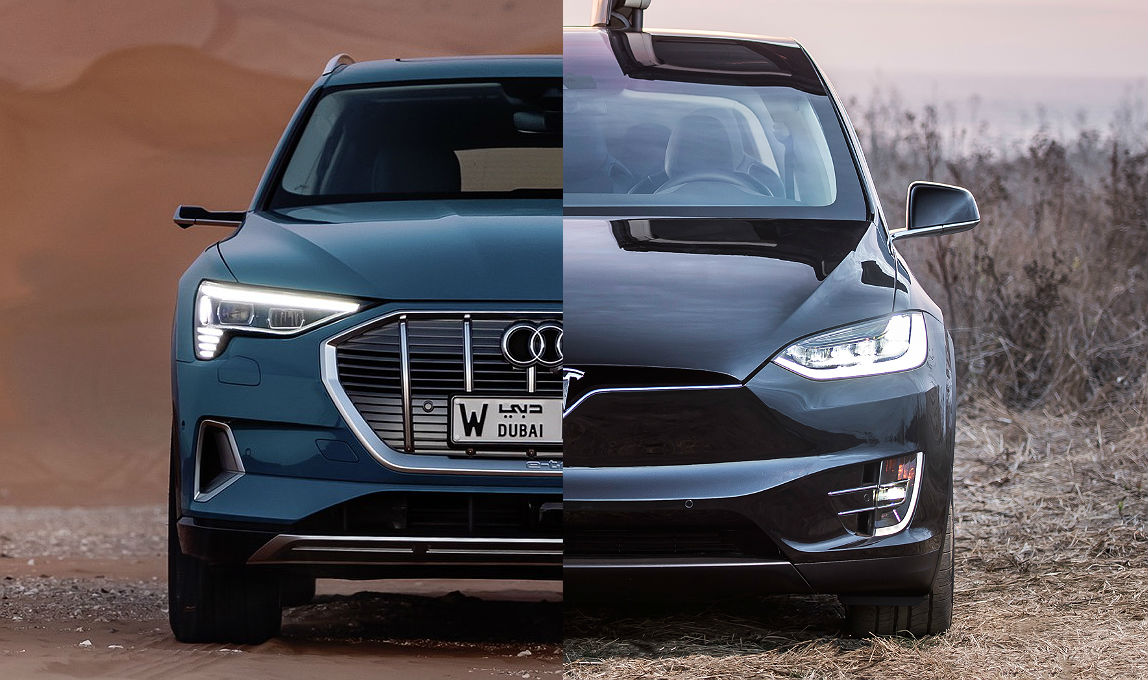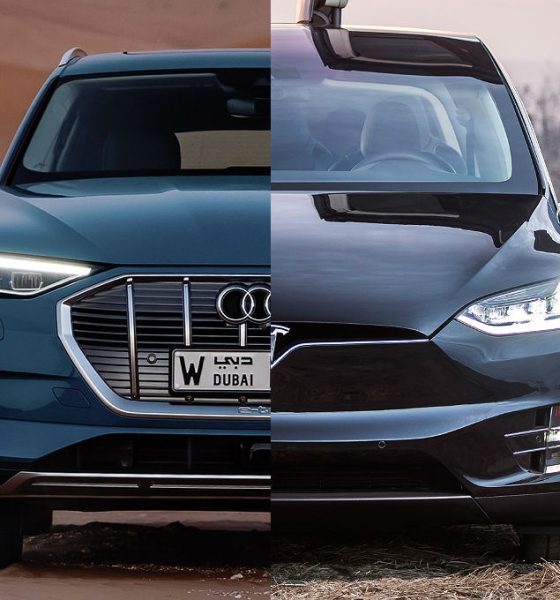

News
Once-hailed ‘Tesla Killer’ Audi e-tron slows down production to just 6 hrs/day: report
The Audi e-tron, once dubbed by avid Tesla critics as a potential “Tesla Killer,” is reportedly running into production problems due to a constrained supply of batteries and a slower-than-expected delivery of electric motors. These production problems have reportedly caused Audi to postpone the release of its upcoming all-electric car, the e-tron Sportback, to 2020, roughly a year later than its intended 2019 release date.
Sources familiar with the activities in Audi’s Brussels plant have told The Brussels Times that the German carmaker is currently being constrained by LG Chem, which supplies the e-tron’s batteries. LG Chem is the supplier of choice for a number of electric vehicles, such as the Porsche Taycan and the Jaguar I-PACE. The local publication’s sources claim that LG Chem is pushing up prices, resulting in Audi having to compete with rival automakers like BMW and Mercedes-Benz to acquire batteries for the e-tron.
This is but half of the e-tron plant’s current issues, according to the Times‘ sources. Audi is reportedly seeing delays in the deliveries of the e-tron’s electric motors as well. The SUV’s electric motors are delivered from an Audi plant in Györ, Hungary, whose workers participated in a strike earlier this year. As a result of these issues, the Brussels plant has reportedly shortened its operations to just 6 hours a day to match production to parts availability. The sources claimed that Audi will likely shift the plant to a 4-day work week in the near future.
It is unfortunate to see Audi encountering production issues with the e-tron, its first all-electric vehicle. Audi is one of the auto industry’s biggest names, having been founded in 1909. Despite its extensive experience in building cars, the company has proven to not be immune to the difficulties of electric car production, something that younger companies such as Tesla have been dealing with for years. Prior to the e-tron’s launch, the vehicle was hyped by Tesla critics as a potential “Tesla Killer,” citing, among other things, Audi’s experience in car manufacturing. As the company is learning now, it appears that building electric cars might not be as easy as Tesla skeptics would think.
Mass producing electric cars is something that Tesla continues to learn. After a gruelling “production hell” with the Model 3, Tesla has arguably become one of the most experienced electric car makers in the auto industry despite its young age. This has allowed the company to have enough foresight to secure the supply of batteries (at least to a large degree) for its electric vehicles, as represented by Gigafactory 1 in Nevada. The company has also opted for a notable degree of vertical integration, producing its vehicles from the ground up using hardware and software that were developed in-house.
The Audi e-tron is equipped with two electric motors that deliver a total power output of 300 kW, as well as a sizable 95 kWh battery that delivers and EPA rating of 204 miles of range on a full charge. The e-tron is no slouch as well, being capable of sprinting from 0-60 mph in 5.5 seconds in “Boost” mode. The all-electric SUV is expected to start deliveries in the United States next month, though it remains unsure if there will be delays due to the company’s reported issues in the Brussels plant.

Elon Musk
Elon Musk and Tesla AI Director share insights after empty driver seat Robotaxi rides
The executives’ unoccupied tests hint at the rapid progress of Tesla’s unsupervised Robotaxi efforts.

Tesla CEO Elon Musk and AI Director Ashok Elluswamy celebrated Christmas Eve by sharing personal experiences with Robotaxi vehicles that had no safety monitor or occupant in the driver’s seat. Musk described the system’s “perfect driving” around Austin, while Elluswamy posted video from the back seat, calling it “an amazing experience.”
The executives’ unoccupied tests hint at the rapid progress of Tesla’s unsupervised Robotaxi efforts.
Elon and Ashok’s firsthand Robotaxi insights
Prior to Musk and the Tesla AI Director’s posts, sightings of unmanned Teslas navigating public roads were widely shared on social media. One such vehicle was spotted in Austin, Texas, which Elon Musk acknowleged by stating that “Testing is underway with no occupants in the car.”
Based on his Christmas Eve post, Musk seemed to have tested an unmanned Tesla himself. “A Tesla with no safety monitor in the car and me sitting in the passenger seat took me all around Austin on Sunday with perfect driving,” Musk wrote in his post.
Elluswamy responded with a 2-minute video showing himself in the rear of an unmanned Tesla. The video featured the vehicle’s empty front seats, as well as its smooth handling through real-world traffic. He captioned his video with the words, “It’s an amazing experience!”
Towards Unsupervised operations
During an xAI Hackathon earlier this month, Elon Musk mentioned that Tesla owed be removing Safety Monitors from its Robotaxis in Austin in just three weeks. “Unsupervised is pretty much solved at this point. So there will be Tesla Robotaxis operating in Austin with no one in them. Not even anyone in the passenger seat in about three weeks,” he said. Musk echoed similar estimates at the 2025 Annual Shareholder Meeting and the Q3 2025 earnings call.
Considering the insights that were posted Musk and Elluswamy, it does appear that Tesla is working hard towards operating its Robotaxis with no safety monitors. This is quite impressive considering that the service was launched just earlier this year.
Elon Musk
Starlink passes 9 million active customers just weeks after hitting 8 million
The milestone highlights the accelerating growth of Starlink, which has now been adding over 20,000 new users per day.

SpaceX’s Starlink satellite internet service has continued its rapid global expansion, surpassing 9 million active customers just weeks after crossing the 8 million mark.
The milestone highlights the accelerating growth of Starlink, which has now been adding over 20,000 new users per day.
9 million customers
In a post on X, SpaceX stated that Starlink now serves over 9 million active users across 155 countries, territories, and markets. The company reached 8 million customers in early November, meaning it added roughly 1 million subscribers in under seven weeks, or about 21,275 new users on average per day.
“Starlink is connecting more than 9M active customers with high-speed internet across 155 countries, territories, and many other markets,” Starlink wrote in a post on its official X account. SpaceX President Gwynne Shotwell also celebrated the milestone on X. “A huge thank you to all of our customers and congrats to the Starlink team for such an incredible product,” she wrote.
That growth rate reflects both rising demand for broadband in underserved regions and Starlink’s expanding satellite constellation, which now includes more than 9,000 low-Earth-orbit satellites designed to deliver high-speed, low-latency internet worldwide.
Starlink’s momentum
Starlink’s momentum has been building up. SpaceX reported 4.6 million Starlink customers in December 2024, followed by 7 million by August 2025, and 8 million customers in November. Independent data also suggests Starlink usage is rising sharply, with Cloudflare reporting that global web traffic from Starlink users more than doubled in 2025, as noted in an Insider report.
Starlink’s momentum is increasingly tied to SpaceX’s broader financial outlook. Elon Musk has said the satellite network is “by far” the company’s largest revenue driver, and reports suggest SpaceX may be positioning itself for an initial public offering as soon as next year, with valuations estimated as high as $1.5 trillion. Musk has also suggested in the past that Starlink could have its own IPO in the future.
News
NVIDIA Director of Robotics: Tesla FSD v14 is the first AI to pass the “Physical Turing Test”
After testing FSD v14, Fan stated that his experience with FSD felt magical at first, but it soon started to feel like a routine.

NVIDIA Director of Robotics Jim Fan has praised Tesla’s Full Self-Driving (Supervised) v14 as the first AI to pass what he described as a “Physical Turing Test.”
After testing FSD v14, Fan stated that his experience with FSD felt magical at first, but it soon started to feel like a routine. And just like smartphones today, removing it now would “actively hurt.”
Jim Fan’s hands-on FSD v14 impressions
Fan, a leading researcher in embodied AI who is currently solving Physical AI at NVIDIA and spearheading the company’s Project GR00T initiative, noted that he actually was late to the Tesla game. He was, however, one of the first to try out FSD v14.
“I was very late to own a Tesla but among the earliest to try out FSD v14. It’s perhaps the first time I experience an AI that passes the Physical Turing Test: after a long day at work, you press a button, lay back, and couldn’t tell if a neural net or a human drove you home,” Fan wrote in a post on X.
Fan added: “Despite knowing exactly how robot learning works, I still find it magical watching the steering wheel turn by itself. First it feels surreal, next it becomes routine. Then, like the smartphone, taking it away actively hurts. This is how humanity gets rewired and glued to god-like technologies.”
The Physical Turing Test
The original Turing Test was conceived by Alan Turing in 1950, and it was aimed at determining if a machine could exhibit behavior that is equivalent to or indistinguishable from a human. By focusing on text-based conversations, the original Turing Test set a high bar for natural language processing and machine learning.
This test has been passed by today’s large language models. However, the capability to converse in a humanlike manner is a completely different challenge from performing real-world problem-solving or physical interactions. Thus, Fan introduced the Physical Turing Test, which challenges AI systems to demonstrate intelligence through physical actions.
Based on Fan’s comments, Tesla has demonstrated these intelligent physical actions with FSD v14. Elon Musk agreed with the NVIDIA executive, stating in a post on X that with FSD v14, “you can sense the sentience maturing.” Musk also praised Tesla AI, calling it the best “real-world AI” today.








